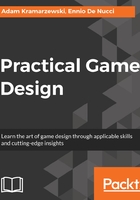
Content lifespan
The content lifespan is a document that lists every significant piece of content and maps it against a player's journey in the game. It allows people to plan the production, estimate which elements are needed first, and identify the areas that have too many or too few new elements.
Unless you're working on a very open-ended game or a sandbox experience, it should be possible to define a player's vector of progression. This vector will serve as the reference point in the lifespan document. To give a couple of examples: in an open world RPG, the vector of progression might be the player's experience level; in a linear puzzle-platformer, it would be the stages themselves; and in an adventure game, it could all come down to the place in the storyline.
Content lifespan documentation can be used to:
- Examine the progression path: If you're focusing on improving the first hour of the game, you'll want to focus your efforts on only the relevant parts
- Pace the end-user experience: It's arguably the easiest way of ensuring that fresh content and game mechanics are properly spread out
- Plan content deliveries: You always want artists and programmers to work on things that you'll need next
- Identify dependencies: No need to work on that new power-up if the gameplay mechanics for it are half a year away!